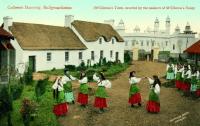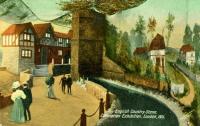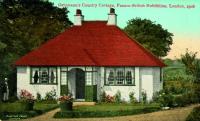Colleens, cottages and kraals:the politics of ‘native’ village exhibitions
Published in 18th–19th - Century History, 20th-century / Contemporary History, Features, Issue 2(March/April 2011), Volume 19
Ballymaclinton—the ‘Irish village’ at the 1908 Franco-British Exhibition in London. The village was so large that jaunting cars took visitors on tours around it.
In the late nineteenth and early twentieth centuries, fake ‘native’ villages—often African but also sometimes Far Eastern—were hugely popular attractions throughout Europe and America at great exhibitions or fairs. They typically took the form of village buildings complete with ‘villagers’ who lived on the site, and metropolitan audiences could wander around watching the ‘villagers’ go about their daily routines and producing traditional crafts. At the height of the age of empire, these displays provided a virtual travel experience to the furthest-flung corners of the world. They always presented the people and cultures of the villages as ‘primitive’, thereby assuring imperial audiences of their own cultural superiority and, by extension, providing popular justification for the imperial projects themselves. The overwhelming majority of these villages were run as commercial ventures rather than state-organised displays but, given that in many cases they were in close proximity to official national pavilions, the distinction was probably not that striking to most visitors.
‘Ballymaclinton’
Within this hugely popular form of entertainment Irish ‘villages’ were fairly common, and often extremely successful. The largest and most successful Irish village ever staged was Ballymaclinton, which appeared at the Franco-British Exhibition in London in 1908. The village was complete with a replica of the Blarney Stone, the St Lawrence Gate in Drogheda, a round tower, a Celtic cross and numerous ‘model’ Irish cottages, along with a staff of 150 Irish men and women (though predominantly women) who lived and worked in the village for the six-month duration of the exhibition and gave demonstrations of ‘traditional’ Irish village life.
Ballymaclinton had a very specific combination of sponsors and interests. It was primarily an advertising and marketing tool for McClinton’s Soap, based in Donaghmore, Co. Tyrone. They specialised in producing a high-quality soap, and by the early twentieth century were an internationally recognised luxury brand whose products included Colleen Shampoo, Sheila Soap and Hibernia Shaving Cream (endorsed in advertisements by the bishop of Bath and Wells). Ballymaclinton was also supported by the Women’s National Health Association, under the leadership of Lady Aberdeen, wife of the Irish viceroy, for the purpose of raising funds and awareness for TB treatment and eradication in Ireland. Ballymaclinton was an extremely successful feature of the Franco-British Exhibition, receiving over two million visitors. Accordingly, it reappeared at the 1909 Imperial International Exhibition, the 1910 Japan–British Exhibition and the 1911 Coronation Exhibition, all held at the Shepherd’s Bush venue.
On the face of it, then, Ballymaclinton was part of the late nineteenth- and early twentieth-century imperial representation of colonised peoples to the metropolitan centres, and certainly it was quite different in its tone and representational style from the exhibition’s official pavilions from dominions such as Canada and Australia.
African ‘villages’ represented differently
Nevertheless, although Irish villages such as Ballymaclinton often appeared alongside African villages (including at the Franco-British Exhibition of 1908, where the only other ‘village’ on display was from Senegal), there were crucial differences in the ways that they represented their respective societies and cultures. Annie E. Coombes has argued that guidebook references typically described Irish (and Scottish) villages in terms such as ‘healthy’, ‘beautiful’ and ‘industrious’, as well as placing great emphasis upon their ancient cultural traditions. By contrast, the African ‘kraals’ and their workers were given no cultural tradition or value, and their cleanliness was frequently questioned.
Indeed, in the instance of Ballymaclinton at the 1908 Exhibition Coombes’s argument could be extended further. Not only did it highlight Irish history and culture, in the form of the reproduction Blarney Stone and round towers, but it also displayed the Irish heritage of an American president in the form of the ancestral cottage of William McKinley, the United States president who had been fatally shot in 1901, ironically whilst attending another exhibition, the Pan-American Exposition in Buffalo, New York. Marking an even greater difference from the African ‘native villages’ at exhibitions, Ballymaclinton also stressed Irish modernity and commerce, in the form of luxury products such as Donegal carpets as well as McClinton’s Soap itself. As a display that was primarily intended to sell luxury soap, the emphasis upon cleanliness in Ballymaclinton’s presentation was predictably strong. Many of the postcards produced to illustrate the village and its women workers bore the tag-line ‘The Irish Colleens use this soap, note their beautiful complexions’. Most strikingly of all, however, Ballymaclinton had its own post office from which visitors could send the specially produced postcards of the village, one of which was entitled ‘Colleens clamouring for their letters’—thus (however unintentionally) stressing that the village workers were literate.
Somali ‘village’ at the 1907 Irish International Exhibition
Coombes’s point about the differences between the ‘villages’ of European cultures and those of Africa is also particularly relevant to the Irish case because, unusually, Ireland (like Scotland) played host to these ‘anthropological’ displays as well as providing their subject-matter. From May to October 1907 Dublin staged the Irish International Exhibition, on the site that would later become Herbert Park in Donnybrook. The single most popular (and profitable) sideshow exhibit was a Somali village. The exhibition’s official catalogue announced that
‘. . . a party of Somalis has been imported from British Somaliland, which is situated in the North East of Africa. This village has been erected to represent the huts in which natives live in this country. A schoolroom has also been built in which Somali children will be taught their lessons.’
Admission was 6d for adults and 3d for children, and it made a profit of almost £10,000 during its operation in Dublin.
So whilst Irish ‘native’ villages were being staged for metropolitan audiences in Britain (and the US), African ‘native’ villages were being staged for Irish audiences, and with great success. At the same time, it seems quite likely that the prime inspiration for Ballymaclinton in 1908 may actually have been the Somali village at the 1907 Irish Exhibition. McClinton’s Soap had contributed a relatively modest display to the Dublin event, consisting of a couple of white-washed and thatched ‘old Irish cottages’, with a number of female staff selling soap, and located in the ‘home industries’ section of the exhibition grounds. Given that only a year later McClinton’s promotional strategy had evolved into the more dramatic staging of Ballymaclinton, it is not unreasonable to suggest that they were influenced by the great popularity of the Somali village with the Dublin crowds. In addition, Ballymaclinton, differentiated from its African equivalents by an emphasis on culture, industry and history, may well have been popular with British visitors in part because it offered a reassuring narrative of a contented Irish identity within the United Kingdom at a time when Home Rule seemed imminent and more forceful versions of Irish nationalism were asserting themselves.

An ‘English Country Scene’ at the 1911 Coronation Exhibition in London. It featured half-timbered fake Tudor houses and watermills, and was in many ways an English ‘Ballymaclinton’.
Enthusiasm for ‘unspoilt’ rural life
Readings of Ballymaclinton as an entirely colonial display of either Irish ‘primitivism’ or Irish contentedness within the United Kingdom for its London audience are complicated, however, by the fact that, by the time Ballymaclinton reappeared at the 1911 Coronation Exhibition, it was joined by an English ‘Tudor’ village, complete with half-timbered cottages and young women with spinning-wheels. Indeed, the Ideal Home Exhibition was also featuring an English Tudor village as its central attraction by 1910, and the Franco-British Exhibition itself included a reconstructed Tudor house and an ideal ‘country cottage’ by the Oetzmann building company, clearly designed to be constructed as a relatively affordable suburban bungalow. So, while the attraction of Ballymaclinton’s ‘Irish’ village for London visitors undoubtedly included an imperial and metropolitan fascination with the apparently ‘primitive’ colonial fringe, it also appears to have been driven by

The Oetzmann building company’s ‘country cottage’ on display at the 1908 Franco-British Exhibition. This design was offered (for £200) as a way of bringing country living to the suburbs.
the general enthusiasm of the era for ‘unspoilt’ rural life, villages and crafts in an increasingly anxious imperial world. This enthusiasm was a popular descendant of the late nineteenth-century Arts and Crafts movement, as well as the Tudor-style houses designed for wealthy clients by architects such as Edwin Lutyens, and was reflected in the establishment of publications such as Country Life magazine (first published in 1897), and indeed the Ideal Home Exhibition itself.
This popular appetite for an ersatz rural life—whether Irish or English—was obviously in part a response to its near-extinction in the British experience, which by the beginning of the twentieth century was highly urbanised and industrialised, with traditional economic and social patterns irrevocably altered even in surviving rural areas. In this respect, Irish (and Scottish) village life presumably represented for English audiences a sense of geographically and politically proximate communities which (they could easily believe) retained their social certainties. The enthusiasm for apparently stable rustic communities—again, whether Irish or English—could also have been fuelled by the considerable anxiety felt in Britain by the early twentieth century about the geopolitical threats of the wider world. The Franco-British Exhibition of 1908 was, after all, staged to celebrate the Entente Cordiale signed between Britain and France in 1904, itself less a statement of actual fellowship between those two nations than one of their shared concerns about German imperial ambitions. By this time Britain saw itself as profoundly threatened by its one-time ally, as could be seen in the extremely popular genre of ‘invasion literature’, including the 1903 Riddle of the sands by Erskine Childers and The invasion of 1910 by William Le Queux, published in 1906. In this respect, all aspects of the popularity of images of idyllic rural life, from fake half-timbered bungalows in the London suburbs to their inhabitants reading Country Life, or indeed visiting Ballymaclinton at the Franco-British Exhibition or the Tudor village at the Ideal Home Exhibition, can also be interpreted as a retreat from the increasingly threatening wider world and into a nostalgic emphasis on home, community and ‘unspoilt’ rural life.
Ballymaclinton therefore appears to have served a variety of purposes for the nearly two million visitors who wandered through its streets and admired its colleens. It represented Irish life as stable and contented in ways that may have comforted those alarmed at the prospect of Home Rule. That stability and contentment may well also have been comforting to those alarmed by the prospect of the even greater disruption to British domestic and imperial peace caused by tensions already brewing across Europe. And the pleasure created by this sense of comfort may well have persuaded them to buy McClinton’s Soap, which, it is worth remembering, was the primary purpose of the entire event. HI
Stephanie Rains is a lecturer in the Centre for Media Studies at NUI, Maynooth. Her Commodity culture and social class in Dublin, 1850–1916 was published recently by Irish Academic Press.
Further reading:
A.E. Coombes, Reinventing Africa: museums, material culture and popular imagination in late Victorian and Edwardian England (Yale, 1995).
B. Siggins, The Great White Fair: the Herbert Park Exhibition of 1907 (Dublin, 2007).
















